Learn how to overcome beat block – also known as writer’s block or producer’s block – and finish more music in this ultimate guide!
Every musician has experienced it before – getting stuck.
You sit down at your DAW excited to work, but you just have no inspiration to make music.
Or, maybe you already have something you like, but you just don’t know where to go next.
However it happens, beat block (also known as writer’s block or producer’s block) is a serious roadblock for many music producers.
Thankfully, there are many things you can do to cure beat block and prevent it from happening again.
But before we get to curing your beat block…
Let’s first examine what exactly it is that we’re curing.
Table of Contents
The Inspiration Problem - What Is Beat Block?

Most artists want to work hard at their art.
But, a lot of the time, we find that we have no inspiration to make music.
We sit there, staring at a blank DAW trying to work…
But no matter what we try, we just feel unmotivated to make music.
So instead of working, we end up just turning our wheels, scrolling Instagram, and not getting any actual work done.
Honestly, it sucks! And it can make you feel like a failure.
Because, after all, how do we work enough to be successful if most of the time we can’t work at all?
Well, the first thing to recognize is that inspiration is an experience, not a choice.
You don’t decide to do it, it happens to you.
It’s a little like the difference between going to bed and falling asleep.
Going to bed is a choice – you choose to get under the covers and turn out the light.
But falling asleep is an experience – when you actually drift off is up to your body, not you.
Inspiration is kind of like that.
So if you don’t feel any inspiration to make music, that’s not something to feel bad about.
Because you’re experiencing something that every producer experiences at some point in their career.
In the music production community, this phenomenon is called “beat block”, but also has other names such as writer’s block or producer’s block.
But thankfully there’s good news.
Even though inspiration isn’t a choice, you can make choices that help you feel inspired.
Because just like you’re more likely to fall asleep if you go to bed, there are things you can do that make you more likely to feel inspired.
Remember: Even Successful Artists Have To Overcome Beat Block
Despite what it may seem, artists aren’t successful because they never experience beat block.
Instead, they’ve implemented methods and practices that help them experience beat block less often and to get through it more quickly when they do.
How To Overcome Beat Block - 10 Proven Methods
First, let’s start off with 10 proven methods that will help you overcome writer’s block in all stages of music production.
These methods will help you get rid of beat block, show you how to get inspiration for music production, and help you out if you’re feeling unmotivated to make music.
So, let’s begin!
Method #1 - Rest Your Mind

One of the simplest things you can do to overcome beat block is to rest.
That’s because taking a break and replenishing your energy can help inspiration grow.
A good rule of thumb is that if you’re never bored, you’re probably doing too much.
In fact, a bit of boredom is actually one of the best ingredients for inspiration!
The reason for this is simple: If you’re always busy, your mind never has a chance to wander and come up with new ideas.
And these new ideas could be the spark you need to get past your beat block!
So be sure to give your mind time to rest.
Here are a few activities that will help you rest your mind, get inspired, and overcome beat block:
- Spend Time Outside – Whether it’s your backyard or a local hiking trail, leave your phone at home and go explore the world. By disconnecting with our phones, computers, and other devices, our brains are forced to connect with the world around us. These new connections make great fodder for inspiration.
- Exercise – Getting up and moving around gives us more than physical benefits. Just by going on a walk or doing a few pushups, we can actually increase our energy levels, and the more energy you have the better the chance that inspiration will strike.
- Do Chores – Doing mundane activities is a great way to overcome beat block. Tasks like laundry, yardwork, and doing the dishes can help us relax our minds while still feeling productive.
Method #2 - Cure Beat Block By Consuming Art

Another thing that can help cure beat block is consuming art.
Whether that means watching a movie, playing video games, or going to a museum…
One of the best ways to get inspired is to go experience art that moves you.
That’s because doing activities like reading, watching movies, or listening to music can give you new ideas.
It can also be a reminder of why making music is important to you, and that can be very motivating.
Method #3 - Overcome Beat Block By Making More Art
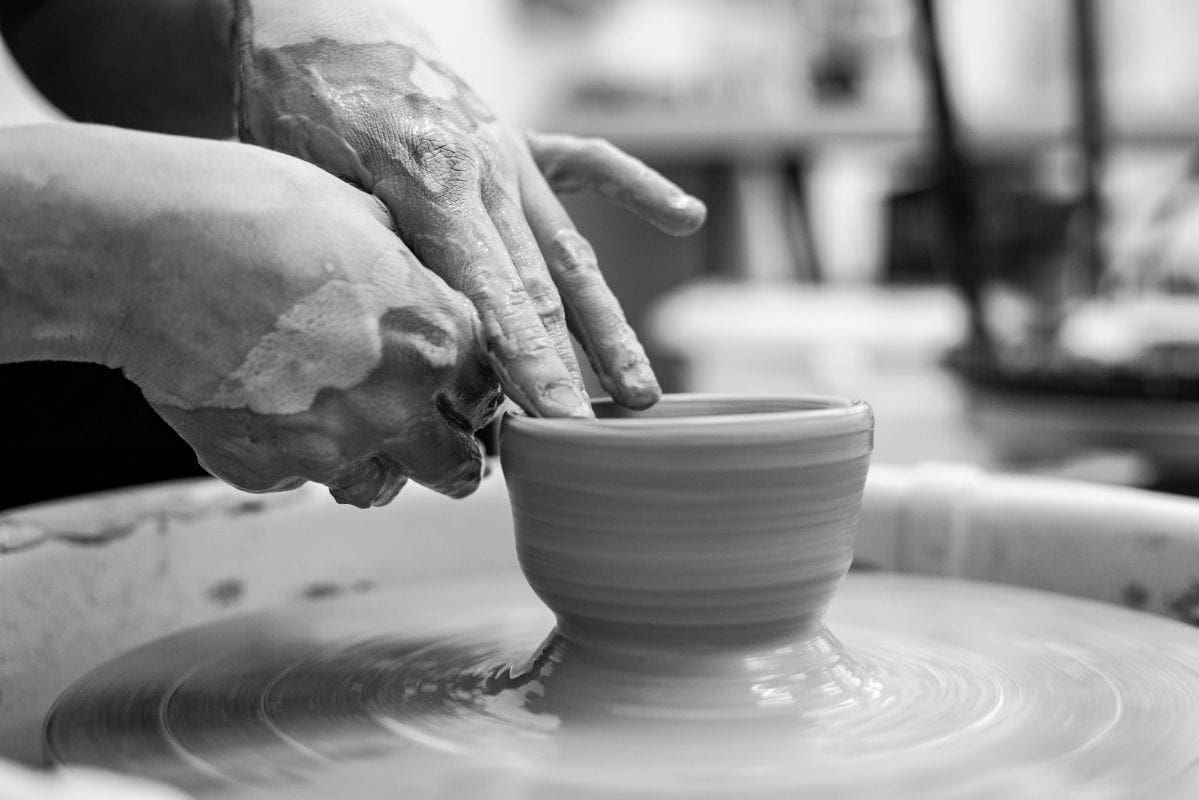
This is one of the most important methods for overcoming beat block – actually doing art!
It might sound circular, but the more art you do, the more often inspiration will strike!
That’s because, in many ways, inspiration is just a “creative misfire”.
Basically, that means that if your mind is used to making creative decisions, it can start mistaking life for art.
Which makes anything you experience feel like inspiration!
For example, something you see on a hike might get interpreted by your creative side, and spark an idea for a piece of music.
You then experience that idea as inspiration!
And the more often you do art, the stronger and more active that creative side is.
Which leads to more and more creative misfires.
So, by doing art consistently enough, whatever you experience day to day can become a source of inspiration and new ideas.
And the best part is that any type of art can strengthen this effect, not just music!
Method #4 - Showing Up
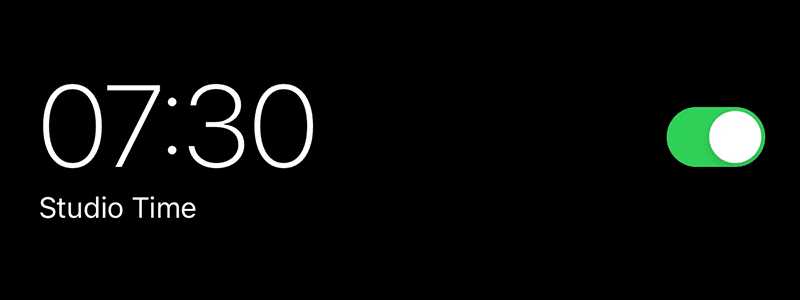
So after reading method #3, you’re probably thinking:
“But I’m unmotivated to make music, that’s why I’m reading this guide!”
And that’s a fair point. So what do you do?
Do you just knuckle down and “willpower” through until you magically overcome beat block on your own?
Or do you just call it a day because you’re not feeling it?
The answer is to knuckle down – but only a little!
Commit to spending a short amount of time every day making music.
Even when you don’t feel like it!
Show up at your workstation and spend 15 or 20 minutes on something creative.
Maybe it’s a small sound design session, or maybe you noodle around on a piano for a bit.
Whatever it is, at the end of that 15 or 20 minutes, you’ll find that you’ve usually gotten into working on something!
This is because the hardest part of music production is often getting started.
If you can get over that first hump, you’ll find that often you’re more prepared to produce than you think.
But, if at the end of that 15 or 20 minutes, you’ve still not gotten into the flow, that’s ok – put it down.
Maybe go do one of the energy restoring activities above.
Or, if you still want to make progress on your music project, maybe try out method #5.
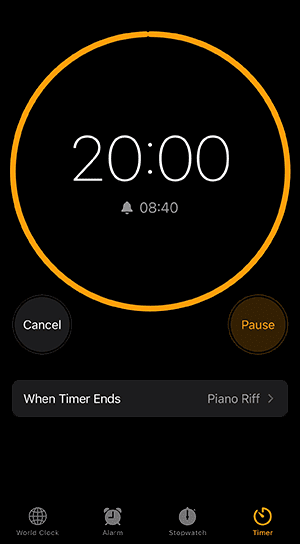
Overcome Beat Block By
Using Small Creative Sessions
Give yourself just 20 minutes of "forced" creative time and see what comes of it!
Method #5 - Do Non-Creative Tasks
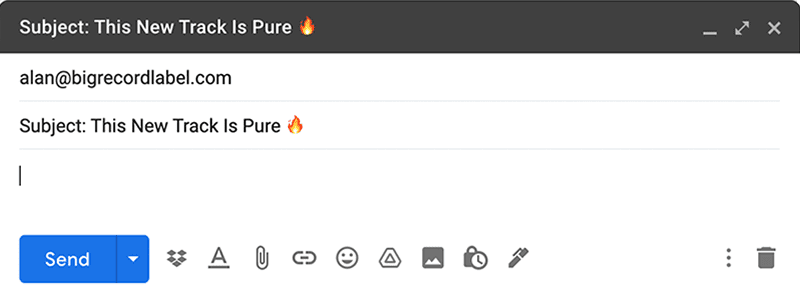
If you want to push your music project forward but you’re not feeling inspired, try working on some of the things artists have to do that aren’t creative tasks.
These non-creative tasks include things like:
- Communicating with fans
- Posting on social media
- Sending out demos to labels
- Booking new shows
These and other “boring” tasks are great things to do when you’re not feeling inspired.
That’s because they’re important to take care of, but they don’t take creativity to do well, only willpower.
And if you do them when you aren’t feeling creative, they’ll be done when you do feel creative.
That way, you won’t have to feel guilty for not doing them while you’re making music!
With this method, you take advantage of the days you do feel inspired, but you can still be productive when you don’t.
Method #6 - Prevent Beat Block By Organizing Your Projects Folder
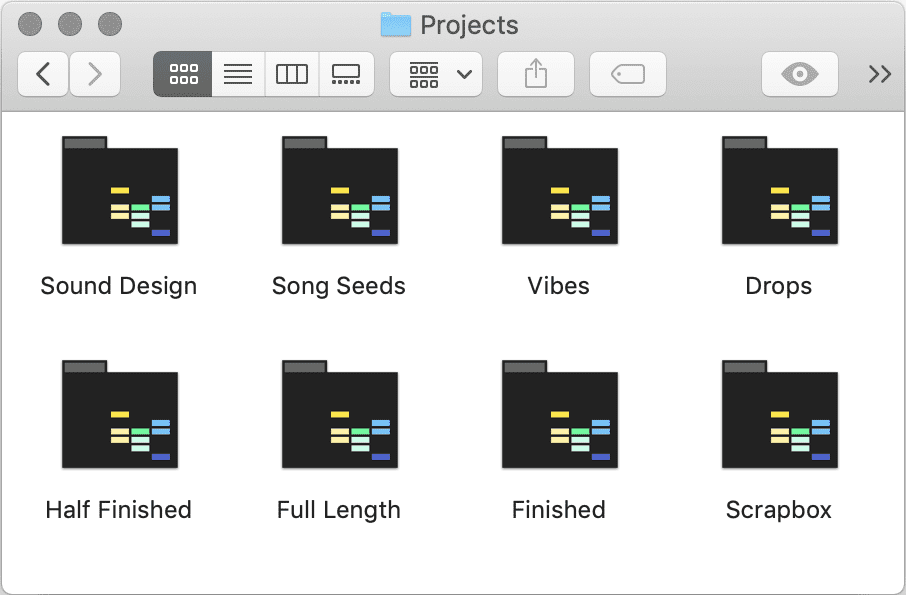
On that note, a handy way to prevent beat block from occurring is to organize your projects folder!
And one of the best ways to organize projects is by how finished they are.
This helps because it lets you control the difficulty level of your work.
The general rule here is that the more finished a project is, the harder it is to work on it.
That’s because any extensions you make have to make sense in the context of everything else!
And the more elements you already have in a track, the more interconnected things have to get.
Here are a few different categories you might want to consider using to organize your project files:
- Sound Design – Projects which have cool sounds you might use, but no good melodies or chords.
- Song Seeds – Projects which are just melodies or chord progressions on a simple sound, just to get the idea down. Many people record voice memos for this purpose!
- Vibes – Loops that sound like intros
- Drops – Loops that sound like drops
- Half Finished – Intro, buildup, and drop, in sequence
- Full Length – Full song structure, but don’t like everything yet
- Finished – Like everything, ready to go to the final mix / final master and release!
- Scrapbox – Projects you don’t want to work on any time soon. These could be cannibalized for other projects or just stored for a rainy day.
Side Note: Never throw projects away or delete them! What doesn’t inspire you today might inspire you in a month! It costs almost nothing to store files these days, so you have no excuse!
If you’re only feeling a little creative, try working on expanding a loop, or doing some sound design.
Or, download one of our packs and get hundreds of new sounds that just might spark your next big idea!
Hint: Our pack Inspiration was built specifically to help musicians overcome beat block!
And if you’re feeling really inspired, open up something that’s half-finished and try to figure out a bridge!
In this way, you can meet yourself wherever you are that day.
The sweet spot is to make sure you feel challenged, but not overwhelmed by the task at hand.
If you can nail that balance, you’re a lot more likely to get into a creative flow and finish more music!
Method #7 - Avoid Beat Block By Starting With A Template
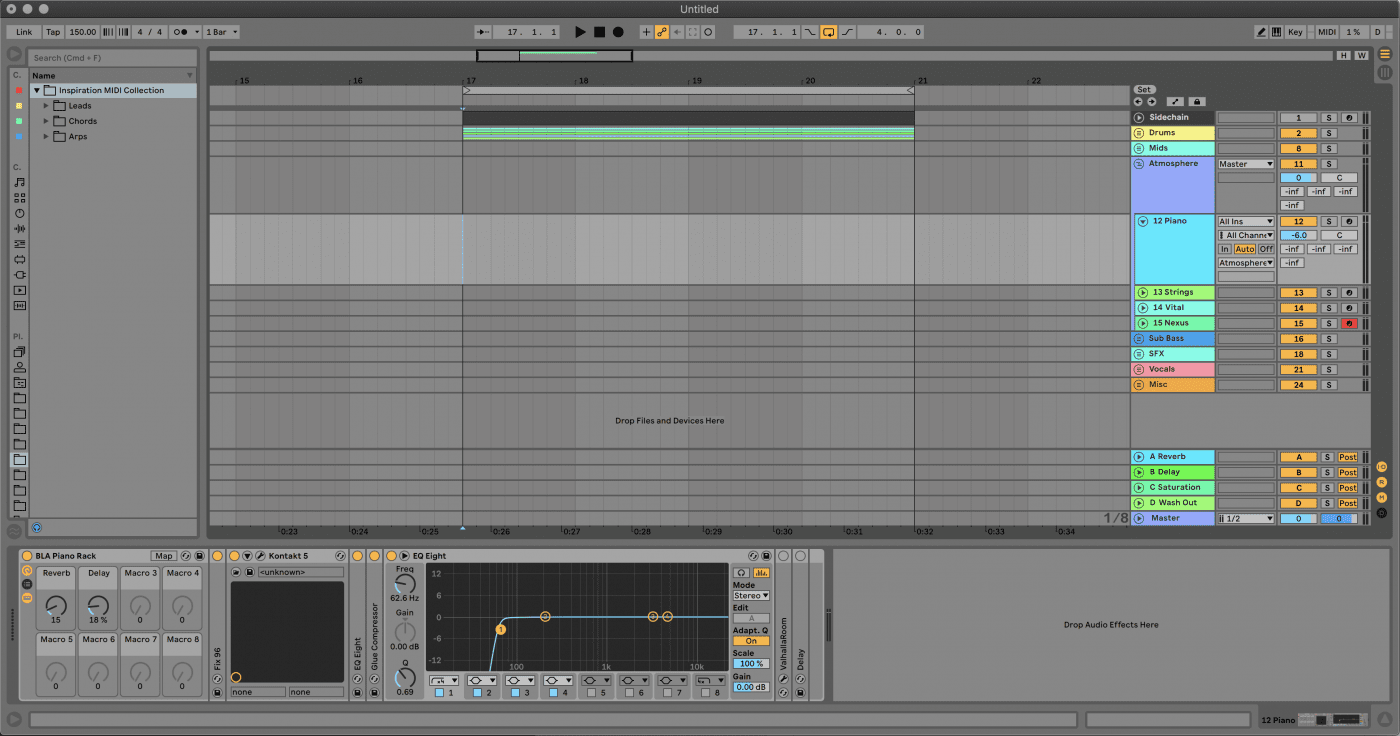
Of of the best ways to prevent beat block in the studio is to remove all of your setup time!
If you find yourself opening your DAW and having to drag in the same piano you always use, setting up the same sidechain, or reaching for any other thing that you know you’re going to use, try making a template!
By using a custom template, like the one shown above, you can cut almost ALL of your setup time and get right to work the moment you open your DAW
What do you put in your template?
Well, that’s largely up to you and your workflow.
But to give you a starting point, here’s what we put in our template above:
- All sidechains are set up and routed.
- Our favorite drum samples are selected and put in their own drum racks (Kicks, Snares, Hats, Etc.) and grouped.
- The “Mids” channel is pre-loaded with everything we need for a drop (Ex: Your favorite supersaw and bass patches).
- All of our atmospheric instruments that don’t play during the drop have been selected and grouped, such as pianos, strings, pads, etc.
- A separate sub-bass channel is set up, complete with processing, sidechain, etc.
- Our go-to SFX samples have been added to their respective drum racks (Impacts, Risers, Etc.) and grouped.
- A group is set up for vocals and vocal elements, complete with processing, panning, etc.
- The misc group is for things that don’t fit into the above or that we don’t regularly use Elements put here can be sorted into their proper groups later.
- Return tracks are set up with go-to effects and processing.
- All channels have basic processing and frequently used effects already applied to them as necessary.
- Our master is set up with a basic mastering chain.
If that seems like a lot, to you…
Good, because it is!
And if you’re taking the time to select and set up every single one of those elements, your brain will quickly get fatigued.
Once that happens, your chances of feeling unmotivated to make music start increasing like crazy.
So take the time to set up a template that contains everything you regularly use.
It doesn’t have to be crazy complicated or include everything you might use, just the essentials are good.
Using a template will save you time, increase your output, and help prevent beat block from occurring!
Method #8 - Know What To Fix (And When!)
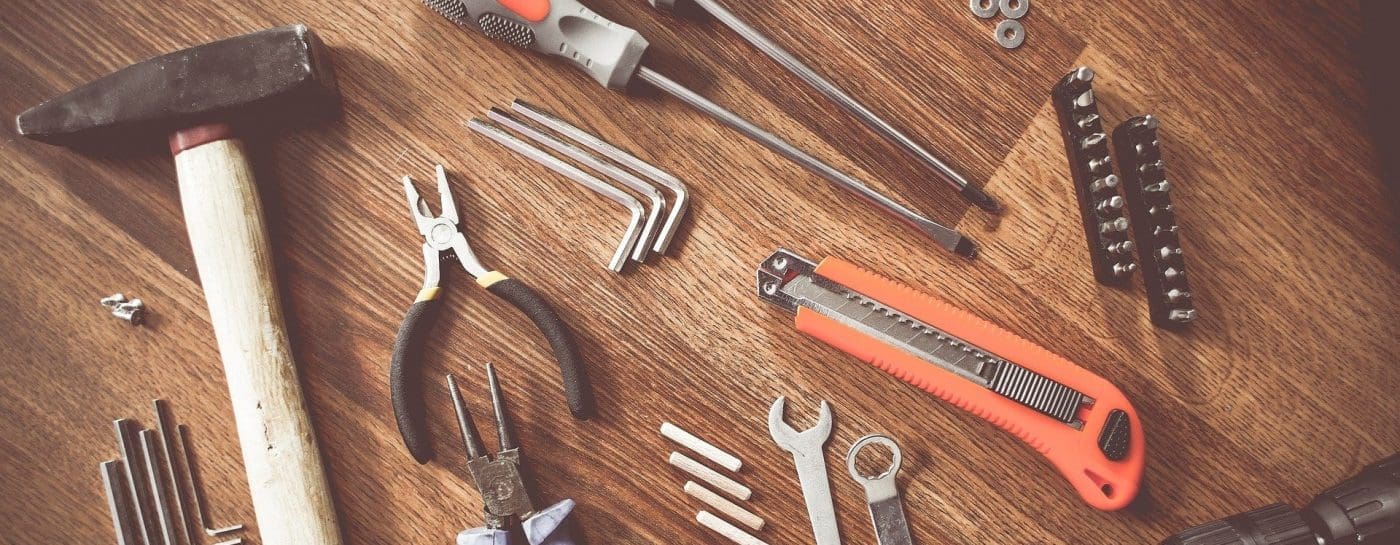
Even if you do manage to get some inspiration going, you can still get hit with beat block.
Usually, you’ll be making great progress, working hard, and crafting something that’s going to put your project on the map.
But then suddenly it hits you – You’ve spent the last hour tweaking the details of the mix instead of writing music!
And when you try to switch back to writing mode, you find that you have no inspiration to write music.
That’s because, without knowing it, you switched from writing mode to mixing mode.
Mixing is an analytical process – you’re looking for problems and fixing them.
But if you’re in the mindset of looking for problems, most creative ideas sound like bad ideas.
You might discard options that you think would sound bad without even testing them!
Don’t be fooled – you don’t know how it’ll sound until you try it!
Remember, there’s a time and place for perfectionism, and trying to write music isn’t it.
And if you find yourself having spent 20 minutes making an EQ curve that looks like this, try to zoom back out mentally:
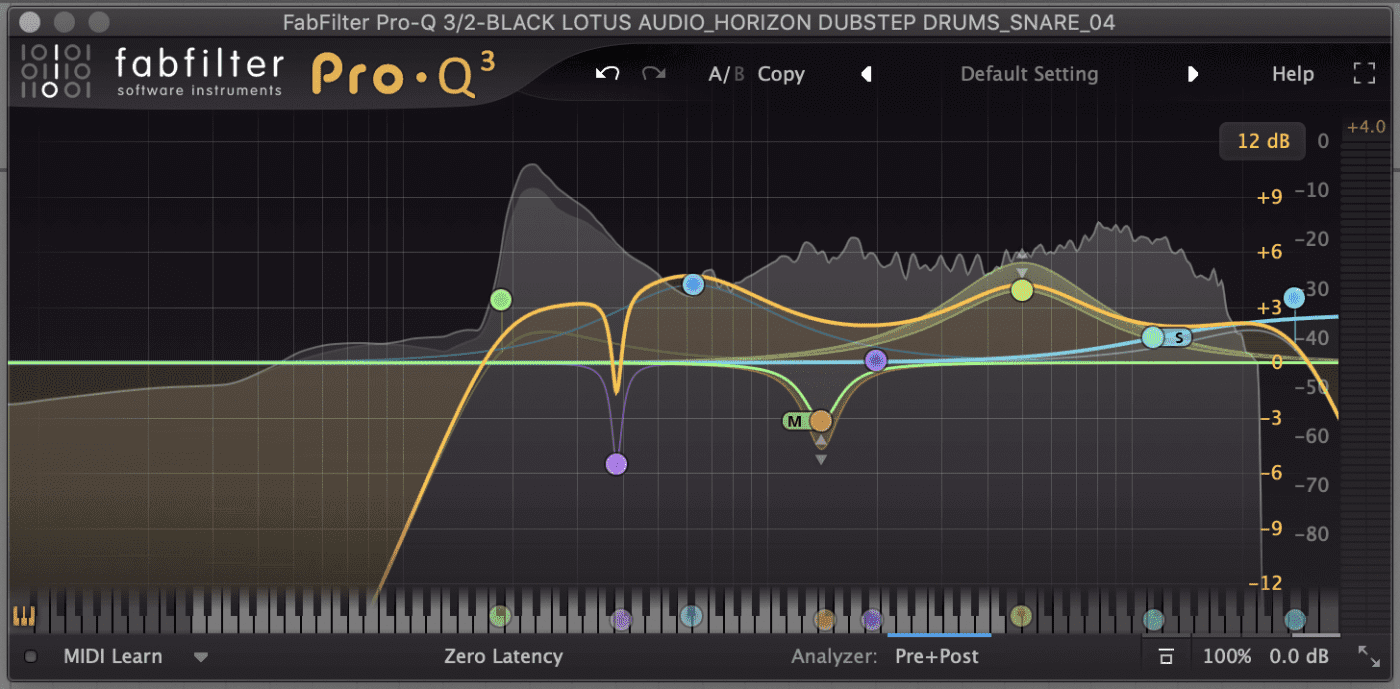
Play the track from the beginning and try to open up your focus again.
Trust that if it’s a real problem in the mix, you’ll still hear it tomorrow.
You will always be able to fix it later!
Because early in the writing process, the details of a mix don’t matter much.
Do what you have to do to get it 80% of the way there, so you’ve got a rough idea of what it might sound like.
But until then, wait until you have the rest of the track to use as context while you polish everything!
What sounds good right now might sound terrible once you add your bridge or another instrument.
Method #9 - The Importance Of Deleting
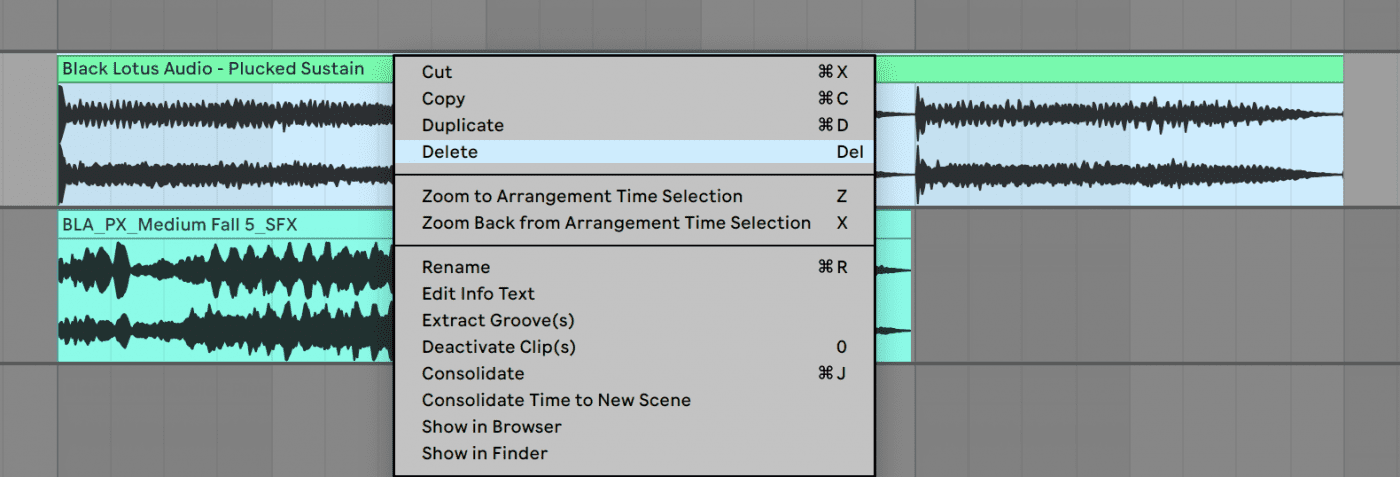
Certain choices can result in creative dead-ends that don’t lead anywhere and cause beat block to pop up.
So if you open up a project don’t like how it sounds, but you used to, it means something surprising…
Something you added or changed made it worse!
Try muting various elements of your mix and playing it over.
If you don’t miss them when they’re gone, delete them.
It sounds harsh, but it’s as important as pruning deadheads from a flowering plant!
Because by getting rid of things that are dead and not working, you’re giving new things room to grow!
Remember, if your mix is already full, but it doesn’t sound the way you want, you can’t just keep adding more elements.
You have to make space for new things in order to replace old ones!
And as you open up space, you’ll often find yourself starting to hear new ideas.
Replacements for the elements you mute will start to present themselves to you.
If you’re finishing working on a project for the day, and you have an element that isn’t quite working, mute it before saving!
That way, when you open it back up again, you’ll listen to it first without that element, which lets you “hear” new ideas.
And if you still don’t hear anything, you can always unmute to see what you were working on before.
Sometimes the new you knows how to fix the problem that the old you didn’t!
Method #10 - Distinguishing Songs From Tracks
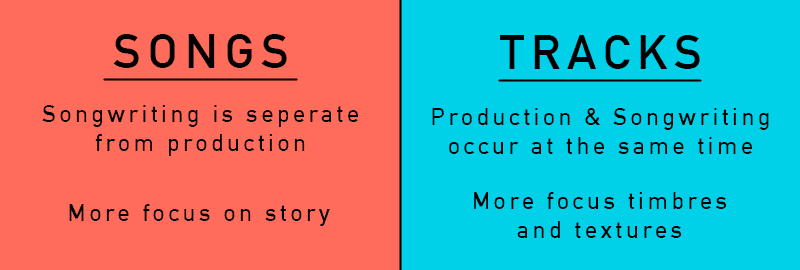
When you’re working on music, it’s important to know what kind of music you’re working on.
That’s because the writing and production styles differ between different kinds of music.
For the context of this post, we’ll say that:
- You write “songs” if you’re writing vocal focused music that tells a story.
- You write “tracks” if you produce dance music that emphasizes sound and energy.
Songs
When writing songs, it’s often helpful to separate “songwriting” from “production”.
Sit down with your instrument and a notepad, and focus on telling your story first!
Come up with your vocal line, and some accompanying chords first, using simple sounds.
If it sounds compelling on voice and piano, it’ll sound good on anything!
Once you’ve written your music and lyrics, you can then transition to your DAW.
From there, “layer up”, adding new sounds, building around your vocal as the centerpiece.
Working this way, you’re less likely to encounter production issues that result in beat block!
Tracks
By contrast, if you write tracks, songwriting and production often go hand in hand.
Dance music is all about timbre and texture and loudness!
As such, sound design and mix are important contexts for musical choices you might make.
So the simplest way to start is by making a loop!
You might begin with an arpeggio, or a drum pattern, or some chords, and then start layering up, adding parts.
Ideally, you’d like to make a finished 8-bar “vertical slice” of your finished song, which you can use as a song section.
Then, work by expanding outward – as we’ll talk about in the next section!
Overcoming Beat Block At Various Stages Of Production
Beat block can strike during any stage of production, whether you’re just starting a track or are close to finishing.
That’s why we’ve included these stage-specific ways to overcome beat block.
Now you’ll have the tools to push forward, no matter what stage of production your song is at!
Getting Started - From Nothing To A Loop
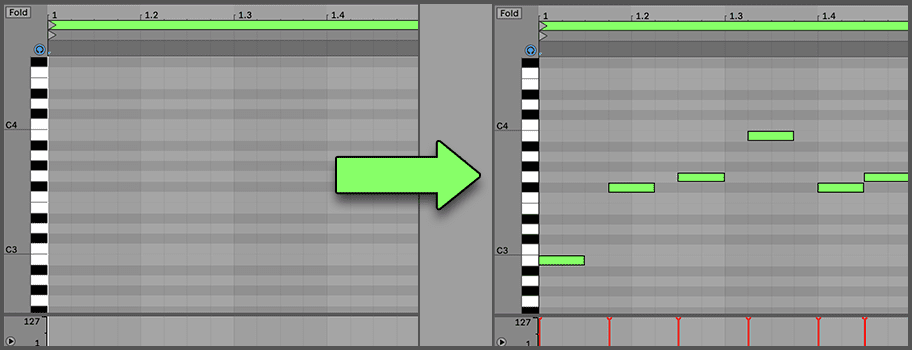
Most producers experience beat block when starting new projects.
Which makes sense, because staring at the empty playlist or piano roll, with no ideas can be paralyzing!
You’re faced with tons of options, but no idea how to choose one and get started.
This is what we call “blank page syndrome”, which occurs when you’re faced with a blank canvas and no clear starting point!
Aside from starting from a template, one of the best ways out of the blank page, strangely enough, is fewer options.
That’s because self-imposed limitations are a great way to make your first step more clear.
Necessity can inspire creativity – so try doing something out of the ordinary:
- Force yourself to use a drum sound in place of your lead instrument.
- Or make an entire track using only one synth (and no external effects).
- Read the manual of a synth you want to learn better, and explore each feature for yourself as you read about it.
However you do it, challenge yourself to get outside your comfort zone.
At worst, you don’t like what you make – but at best, it gives you a place to start.
You can always break the rules once you get going, or delete what you make, what matters is making a move – any move!
If you have no inspiration to make music, we can help!
We run weekly production challenges on our discord server that will help you overcome beat block in the studio.
So if you’re looking to spice things up in the studio while connecting with other music producers, come join us on Discord!
Breaking Out - Turning A Loop Into An Arc
Electronic artists tend to get stuck in 8 or 16 bar loops.
You like how it sounds, but can’t figure out where to go from there.
Well, have no fear, because expanding the loop is easy once you know how to do it!
Start By Assessing The Energy Level
How energetic is your loop, on a scale of one to ten?
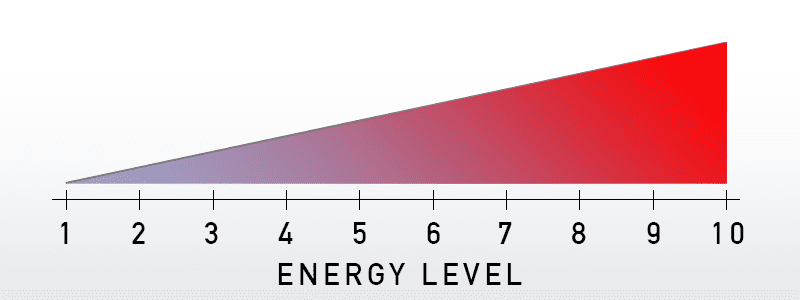
If it’s a 1-4, you’re probably going to use this loop to form your introduction.
And If it’s an 8-10, you’re probably working with your drop!
If you’re in that middling range, from 5-7, you’re in a tough spot.
You might have something that sounds like the breakdown after a drop!
Or, it might be somewhere in the middle of building up, but not quite arrived yet.
Or, unfortunately, it could just be confused, and not know what it’s trying to be at all!
Either way, if you’ve got middling energy, you’re usually best off trying to move in one direction or the other.
If you need less energy, try filtering or muting elements that live in the high or low frequencies, like drums or basses.
Then, the section might work well as an intro!
If you want more energy, do the opposite! Add high or low-frequency elements, or make your pattern busier.
If you move in that direction, the section might end up becoming your drop!
Once you’ve got something that feels more clearly like a drop or an intro, proceed!
Working Forwards From The Intro
If you’re experiencing beat block but you’ve managed to get a small loop going, try muting a few of your melodic elements.
Oftentimes, this will give you an introduction that helps you build into the rest of the track.
To illustrate this method, we’ve created the following example:
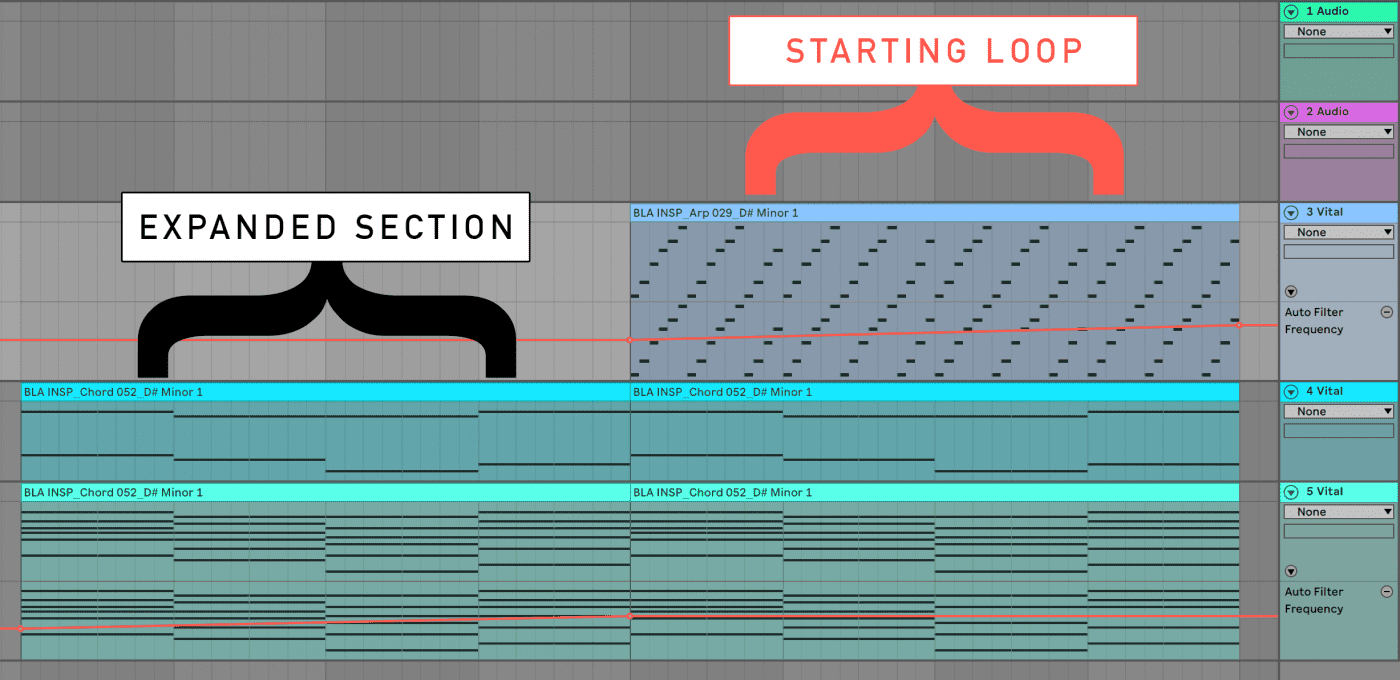
We started with the loop on the right – the “Starting Loop”.
This loop consisted of three layers: An arpeggio and two pad layers.
First, we muted the most energetic element in the loop, which was the arpeggio.
Without the arp, the loop still sounded good, so we now had two sections to work with! (Progress!)
However, the transition from soft pads to the quick arpeggio was a bit jarring, so we added a low-pass filter to each sound.
We then automated the filter on the arp to be barely audible when it started, and then open up over time.
Now we had the makings of a buildup, and had more ideas for what might follow.
And the more layers you have, the more times you can repeat this process, and the longer your intro gets.
Just make sure each time through that the new elements make it feel interesting again.
Because if it sounds too similar, listeners will get bored. And you don’t want that!
So try playing around with the order you introduce things and adding in new parts when you think of them.
And now that you’ve overcome your beat block and got an intro going, your track will quickly start to take shape!
With a little luck (and maybe a riser or two), you’ve got yourself a full arc, from introduction to drop!
And with that your track is half-finished!
*Wo-oah, we’re halfway there!”
Working Backward From The Drop
When you’re working backward from your drop, the same rule of thumb applies.
You’ll usually want your drop and your intro to share a few elements, so try and figure out what those would be!
Once you’ve decided, solo them on their own, and try adding some melodic elements around them.
In this way, you foreshadow what’s to come in the drop that you’ve made, so when the listener gets there, it’s familiar!
Again, we created an example to illustrate this process:
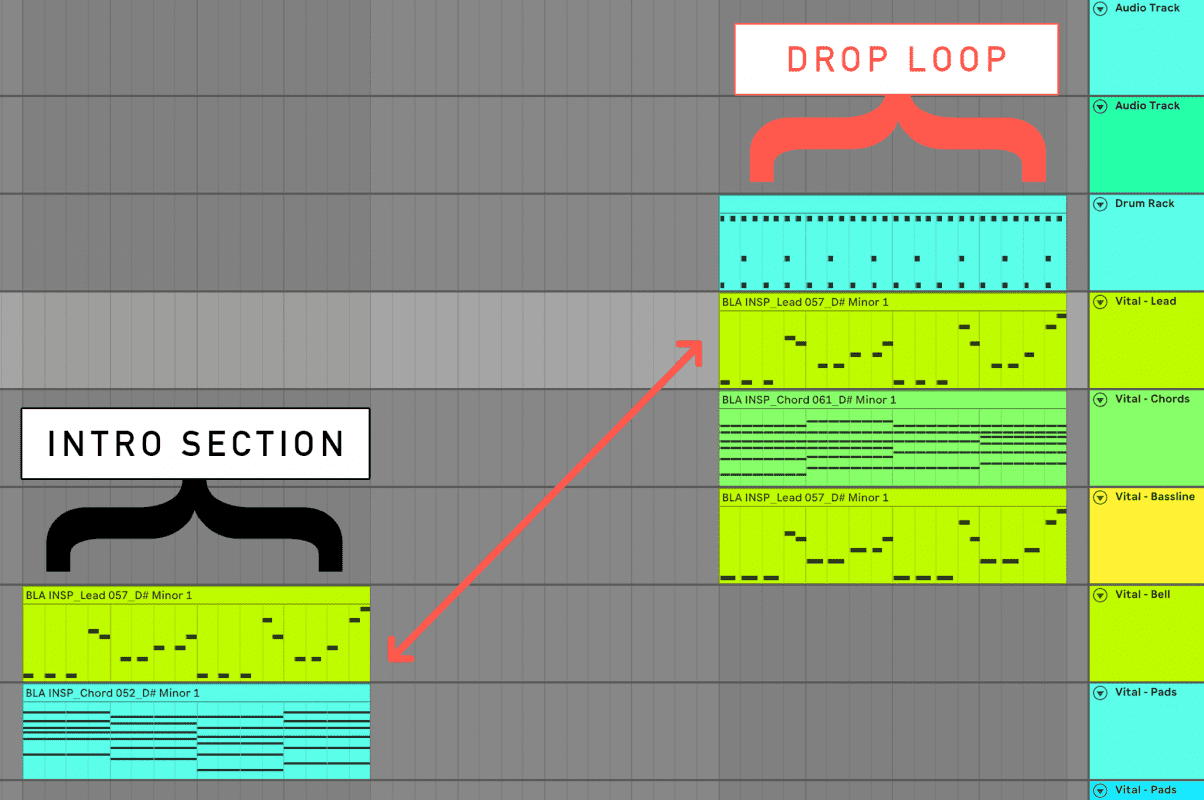
We started with a high-energy drop loop that contained drums, a lead melody, some chords, and a bass line.
Knowing that we wanted the lead melody to be introduced earlier, we put it in our intro with the same pads used in the previous example.
However, instead of using the same sound for the melody that’s used in the drop, we swapped it out for a bell sound that was lower in energy.
This way, we could introduce the melody subtly so that listeners are familiar with it when it plays during the drop!
Another fun trick we used was to “reharmonize” our lead melody.
That is, we used the same melody for both the drop and intro, but put it in a different context by using a different bassline chord progression underneath.
That way, when the listener arrives at your drop, they’ll be able to hum or sing along, but the chords will make things more interesting!
Finishing Up - From An Arc to a Full Piece

Finally, you can see the light at the end of the tunnel!
You’re making great progress in the studio, and it feels like your beat block is a problem of the past!
But now you’re in for the toughest part – figuring out the bridge and variations.
Bridges and variations are hard because of what they’re supposed to do.
The function of a bridge is to give the listener a break from what they’ve been hearing, a “palate cleanser” of sorts.
Variations do the same thing – they keep the listener from getting bored, hearing the same thing twice.
If the bridge or variation is too similar, it doesn’t do its job of refreshing the listener.
But if they’re too different, they stop sounding like the same song!
Striking the balance is tough, and that’s why so many tracks never make it past this critical step.
Thankfully, we have one last trick to help you out.
Bonus Trick - The importance of Distance

Taking breaks while working on projects is always a good move, but especially so here.
If you don’t have any ideas for a bridge, set the track down and go make something else!
When you look at the name of the project and don’t remember how it sounds, that’s the time to open it back up.
By that point, you’ll be able to listen to the track like a new listener would, hearing it for the first time.
This means you’ll get to listen to what it is, not what you originally wanted it to be.
Oftentimes, that’s all you’ll need!
A new section will come to mind based on your expectations as a listener, rather than an artist.
Creating that distance is what lets you stop being the artist, and start being the listener!
Sometimes, this can almost feel like collaborating with your past self!
This is also why it’s important not to listen too much to your unfinished tracks.
If you keep refreshing the idea in your head, you can get stuck, or worse, get bored of it!
As a rule of thumb, only allow yourself to listen to what you worked on yesterday.
If you immediately have an idea of how to extend it, great, go work on it!
And if not, no worries, just move on to the next project.
Then, at some regular interval (say, once every few weeks), go back and listen to old projects.
Sift through your projects folder and take the time to listen to the ones you don’t remember anymore.
Once again, if you have an idea, follow it up, and if not, don’t worry about it!
Ideas are also experiences, not choices, so if nothing is coming, don’t sweat it.
All you have to do is keep living, and experiencing new things.
The next time you listen, you’ll be a different person, with different insights.
Maybe that you will have an idea for how to move forward with it!
As a fair warning, you do wind up with a lot of in-progress material doing this, but that’s fine.
Having a lot of projects going means you have a lot of variety in what you can work on!
Any given day, you’re more likely to have something that you’re in the specific mood for.
Wrapping Up - How To Overcome Beat Block

Making music is tough, and you’re bound to hit a roadblock every once in a while.
It takes practice and effort, over a long period to make your best work.
But the good news is it’s not a race.
It’s never too late to start, and it’s never a waste of time as long as you enjoy the process of doing it.
So the next time you get stuck, come back and re-read this.
Maybe you’ll get something new out of it that didn’t make sense before!
Until then, good luck, and happy producing!
Get 800+ Hard-Hitting Dubstep Presets, Samples, & Wavetables.
Our best deal ever. Take your music to the next level with 5 complete premium packs for every style of dubstep.

Unlocking the Power of Presets: What We Learned from Protohype’s Knights Demo
Veteran mastering engineer Aaron Roman shares 5 tips on mastering electronic music (EDM) for Spotify.
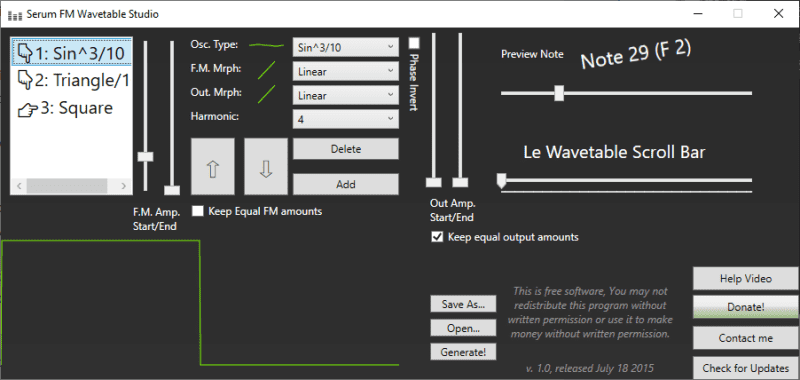
How to Make Custom FM Wavetables with Serum FM Wavetable Studio
Wavetables are an essential tool when sound designing and creating your own sounds. It is the brains and the fundamental
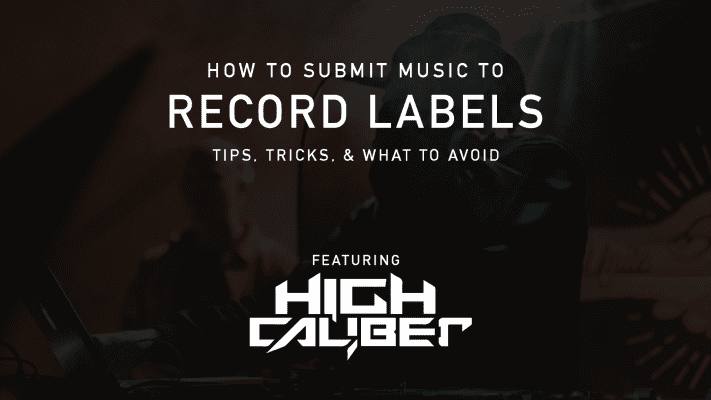
How To Submit Music To Record Labels | Tips, Tricks, & What To Avoid
Learn how to submit music to record labels with these tips from High Caliber Records.

Unlocking the Power of Presets: What We Learned from Protohype’s Knights Demo
Veteran mastering engineer Aaron Roman shares 5 tips on mastering electronic music (EDM) for Spotify.

How to Make Custom FM Wavetables with Serum FM Wavetable Studio
Wavetables are an essential tool when sound designing and creating your own sounds. It is the brains and the fundamental

How To Submit Music To Record Labels | Tips, Tricks, & What To Avoid
Learn how to submit music to record labels with these tips from High Caliber Records.
Share This Post With Your Friends

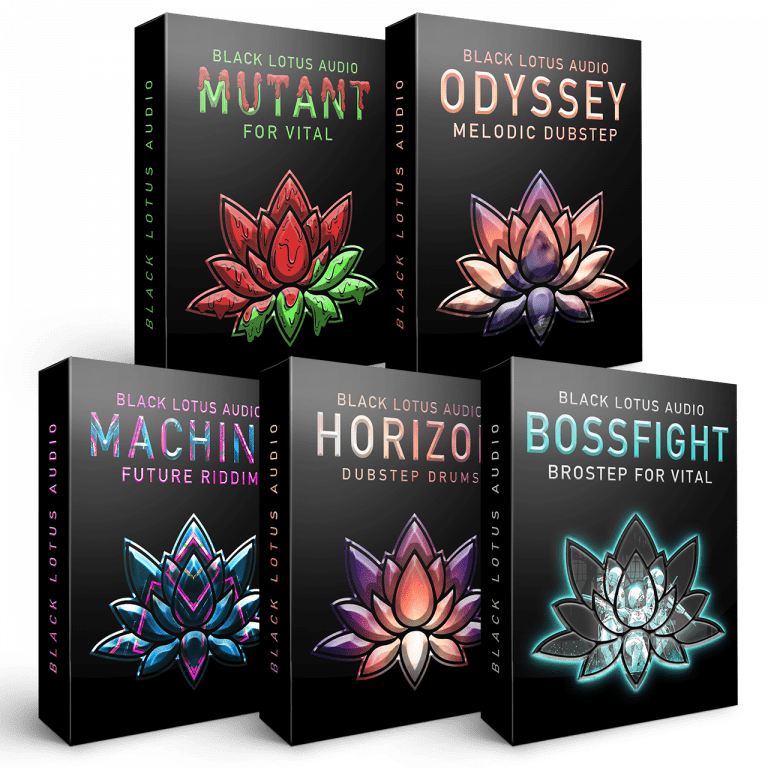
Comments are closed.